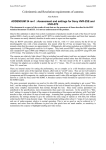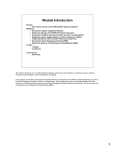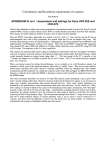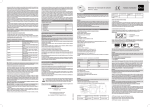Download DTD-523X Digital Clock Installation and Operation
Transcript
Digital Time/Date Display Clocks DTD-5230, DTD-5231, and DTD-5233 Installation and Operation Manual Edition B 175-000025-00 DTD-5230, DTD-5231, and DTD-5233 Digital Time/Date Display Clocks Installation and Operation Manual Edition B October 2006 Trademarks and Copyrights CCS, CCS CoPilot, CCS Navigator, CCS Pilot, Command Control System, CineTone, CinePhase, CineSound, DigiBus, DigiPeek, Digital Glue, DigiWorks, DTV Glue, EventWORKS, EZ HD, Genesis, HDTV Glue, Image Q, Icon, IconLogo, IconMaster, IconMaster Nav, IconSet, Icon Station, Inca, Inca Station, InfoCaster, Inscriber, Inscriber CG—FX, Integrator, LeFont, Leitch, LogoMotion, MediaFile, MIX BOX, NEO, the NEO design, NEOSCOPE, NewsFlash, Nexio, Opus, Panacea, PanelMAPPER, Platinum, Portal, PROM-Slide, RouterMAPPER, RouterWORKS, Signal Quality Manager, SpyderWeb, SuiteView, TitleMotion, UNIFRAME, Velocity, VelocityHD, VideoCarte, Videotek, and X75 are trademarks of the Harris Corporation, which may be registered in the United States, Canada, and/or other countries. All other trademarks are the property of their respective owners. Copyright 2006, Harris Corporation. All rights reserved. This publication supersedes all previous releases. Printed in Canada. Warranty Information The Limited Warranty Policy provides a complete description of your warranty coverage, limitations, and exclusions, as well as procedures for obtaining warranty service. To view the complete warranty, visit www.broadcast.harris.com/leitch. Contents Preface Manual Information .................................................................................v Purpose ..............................................................................................v Audience ...........................................................................................v Revision History ...............................................................................v Writing Conventions ....................................................................... vi Obtaining Documents ..................................................................... vi Unpacking/Shipping Information ......................................................... vii Unpacking a Product ...................................................................... vii Product Servicing ........................................................................... vii Returning a Product ....................................................................... vii Restriction on Hazardous Substances (RoHS) Compliance ................ viii Waste from Electrical and Electronic Equipment (WEEE) Compliance ix Safety .......................................................................................................x Safety Terms and Symbols in this Manual .......................................x Chapter 1: Introducing the DTD-523X Clock Series Overview ..................................................................................................1 Available Models ..............................................................................2 Chapter 2: Installing the DTD-523x Overview ..................................................................................................3 Installation Requirements ........................................................................4 Rack Mounting .................................................................................4 Cooling ..............................................................................................4 Rear Panel Installation .............................................................................5 Input Switch Functions .....................................................................5 Power Supply ...........................................................................................5 DTD-5230, DTD-5231, and DTD-5233 Installation and Operation Manual iii Contents Chapter 3: Operation Overview ................................................................................................. 7 Setting the Control Mode ........................................................................ 8 Clock Mode ...................................................................................... 9 Timecode Reader Mode ................................................................. 10 Secondary Reference Mode ........................................................... 10 Auxiliary Offset ............................................................................. 11 Date Display ................................................................................... 12 Timecode Generator Mode ............................................................ 12 Brightness Adjustment ................................................................... 13 Clock Setting ......................................................................................... 14 Manual Time Setting ...................................................................... 14 Local Offset Programming ............................................................. 15 Chapter 4: Specifications Overview ............................................................................................... 17 Input Specifications ........................................................................ 18 Output Specifications ..................................................................... 18 Electrical Specifications ................................................................. 18 Time Base Specifications ............................................................... 19 Control Specifications .................................................................... 19 Mechanical Specifications ............................................................. 20 Appendix A: Servicing Instructions Overview ............................................................................................... 21 Fuse Replacement ................................................................................. 22 Replacement Procedure .................................................................. 22 Battery Replacement ............................................................................. 23 Battery Use Warnings .................................................................... 23 Replacement Procedure .................................................................. 24 Voltage Selection .................................................................................. 25 Index Keywords .............................................................................................. 27 iv DTD-5230, DTD-5231, and DTD-5233 Installation and Operation Manual Preface Manual Information Purpose This manual details the features, installation, operation, maintenance, and specifications for DTD-5230, DTD-5231, and DTD-5233 Digital Time/Date Display Clocks. Audience This manual is written for engineers, technicians, and operators responsible for installation, setup, maintenance, and/or operation of DTD-5230, DTD-5231, and DTD-5233 Digital Time/Date Display Clocks. Revision History Table P-1. Revision History of Manual Edition Date Comments A March 2002 Full release B October 2006 Manual reformatted and updated DTD-5230, DTD-5231, and DTD-5233 Installation and Operation Manual v Preface Writing Conventions To enhance your understanding, the authors of this manual have adhered to the following text conventions: Table P-2. Writing Conventions Term or Convention Description Bold Indicates dialog boxes, property sheets, fields, buttons, check boxes, list boxes, combo boxes, menus, submenus, windows, lists, and selection names Italics Indicates E-mail addresses, the names of books or publications, and the first instances of new terms and specialized words that need emphasis CAPS Indicates a specific key on the keyboard, such as ENTER, TAB, CTRL, ALT, or DELETE Code Indicates variables or command-line entries, such as a DOS entry or something you type into a field > Indicates the direction of navigation through a hierarchy of menus and windows hyperlink Indicates a jump to another location within the electronic document or elsewhere Internet address Indicates a jump to a Web site or URL Note Indicates important information that helps to avoid and troubleshoot problems Obtaining Documents Product support documents can be viewed or downloaded from our Web site at www.broadcast.harris.com/leitch (go to Support> Documentation). Alternatively, contact your Customer Service representative to request a document. vi DTD-5230, DTD-5231, and DTD-5233 Installation and Operation Manual Preface Unpacking/Shipping Information Unpacking a Product This product was carefully inspected, tested, and calibrated before shipment to ensure years of stable and trouble-free service. 1. Check equipment for any visible damage that may have occurred during transit. 2. Confirm that you have received all items listed on the packing list. 3. Contact your dealer if any item on the packing list is missing. 4. Contact the carrier if any item is damaged. 5. Remove all packaging material from the product and its associated components before you install the unit. Keep at least one set of original packaging, in the event that you need to return a product for servicing. Product Servicing DTD-5230, DTD-5231, and DTD-5233 Digital Time/Date Display Clocks are not designed for field servicing. All upgrades, modifications, or repairs require you to return the product to the Customer Service center. Returning a Product In the unlikely event that your product fails to operate properly, please contact Customer Service to obtain a Return Authorization (RA) number, then send the unit back for servicing. Keep at least one set of original packaging in the event that a product needs to be returned for service. If the original package is not available, you can supply your own packaging as long as it meets the following criteria: • The packaging must be able to withstand the product’s weight. • The product must be held rigid within the packaging. • There must be at least 2 in. (5 cm) of space between the product and the container. • The corners of the product must be protected. DTD-5230, DTD-5231, and DTD-5233 Installation and Operation Manual vii Preface Ship products back to us for servicing prepaid and, if possible, in the original packaging material. If the product is still within the warranty period, we will return the product prepaid after servicing. Restriction on Hazardous Substances (RoHS) Compliance Directive 2002/95/EC—commonly known as the European Union (EU) Restriction on Hazardous Substances (RoHS)—sets limits on the use of certain substances found in electrical and electronic equipment. The intent of this legislation is to reduce the amount of hazardous chemicals that may leach out of landfill sites or otherwise contaminate the environment during end-of-life recycling. The Directive takes effect on July 1, 2006, and it refers to the following hazardous substances: • Lead (Pb) • Mercury (Hg) • Cadmium (Cd) • Hexavalent Chromium (Cr-V1) • Polybrominated Biphenyls (PBB) • Polybrominated Diphenyl Ethers (PBDE) According to this EU Directive, all products sold in the European Union will be fully RoHS-compliant and “lead-free.” (See our Web site, www.broadcast.harris.com/leitch, for more information on dates and deadlines for compliance.) Spare parts supplied for the repair and upgrade of equipment sold before July 1, 2006 are exempt from the legislation. Equipment that complies with the EU directive will be marked with a RoHS-compliant emblem, as shown in Figure P-1. Figure P-1. RoHS Compliance Emblem viii DTD-5230, DTD-5231, and DTD-5233 Installation and Operation Manual Preface Waste from Electrical and Electronic Equipment (WEEE) Compliance The European Union (EU) Directive 2002/96/EC on Waste from Electrical and Electronic Equipment (WEEE) deals with the collection, treatment, recovery, and recycling of electrical and electronic waste products. The objective of the WEEE Directive is to assign the responsibility for the disposal of associated hazardous waste to either the producers or users of these products. Effective August 13, 2005, producers or users will be required to recycle electrical and electronic equipment at end of its useful life, and may not dispose of the equipment in landfills or by using other unapproved methods. (Some EU member states may have different deadlines.) In accordance with this EU Directive, companies selling electric or electronic devices in the EU will affix labels indicating that such products must be properly recycled. (See our Web site, www.broadcast.harris.com/leitch, for more information on dates and deadlines for compliance.) Contact your local sales representative for information on returning these products for recycling. Equipment that complies with the EU directive will be marked with a WEEE-compliant emblem, as shown in Figure P-2. Figure P-2. WEEE Compliance Emblem DTD-5230, DTD-5231, and DTD-5233 Installation and Operation Manual ix Preface Safety Carefully review all safety precautions to avoid injury and prevent damage to this product or any products connected to it. If this product is rack-mountable, it should be mounted in an appropriate rack using the rack-mounting positions and rear support guides provided. It is recommended that each frame be connected to a separate electrical circuit for protection against circuit overloading. If this product relies on forced air cooling, it is recommended that all obstructions to the air flow be removed prior to mounting the frame in the rack. If this product has a provision for external earth grounding, it is recommended that the frame be grounded to earth via the protective earth ground on the rear panel. IMPORTANT! Only qualified personnel should perform service procedures. Safety Terms and Symbols in this Manual WARNING Statements identifying conditions or practices that may result in personal injury or loss of life. High voltage is present. CAUTION Statements identifying conditions or practices that can result in damage to the equipment or other property. x DTD-5230, DTD-5231, and DTD-5233 Installation and Operation Manual Chapter 1 Introducing the DTD-523X Clock Series Overview The DTD-523x series of digital time/date display clocks (including the DTD-5230, DTD-5231, and DTD-5233) replaces the following clocks: • DTD-5200 • DTD-5210 • DTD-5203 Note Except where noted, the term “DTD-523x” is used in this manual to refer to the DTD-5230, DTD-5231, and DTD-5233 digital time/date display clocks. The DTD-523x series are digitally controlled, self-setting clocks. They operate in one of two modes: Stand-alone mode via power line frequency or internal crystal, or with an SMPTE or EBU serial timecode input as either a clock or a timecode reader. When provided with an SMPTE or EBU timecode source, the DTD-523x series of clocks are instantly self-setting. In the event of a power failure, the DTD-523x clocks maintain the correct time internally via a battery-backed timekeeping memory. If power is restored without timecode, the clocks will self-set to the correct time as maintained by the battery backup, and then continue to operate on internal crystal or power-line time base. DTD-5230, DTD-5231, and DTD-5233 Installation and Operation Manual 1 Chapter 1: Introducing the DTD-523X Clock Series DTD-523x clocks automatically decode either SMPTE or EBU timecode inputs. Additionally, these clocks function as timecode generators when operated from their internal crystals. Either SMPTE or EBU timecode can be generated and used to drive other clocks. When driven from the MTG-3901 Master Time Generator or CSD-3901/3902 Clock System Driver, DTD-523x clocks are compatible with a user-defined auxiliary time offset and date. Some abilities are as follows: • Local offset can also be programmed up to 23:59:59. • Time display can be either 12- or 24-hour format, and can display HH:MM:SS or MM:SS.FF. • Dates can be displayed as month:day:year (MM:DD:YY) or day:month:year (DD:MM:YY). In the event of a timecode input failure, the colon LEDs flash at the rate of twice per second. DTD-523x clocks then automatically switch to the user-selected secondary time base, either power line frequency or internal crystal. (The power line frequency is automatically determined during power-up.) If timecode operation is not required, DTD-523x clocks may be set to use the secondary time base permanently, and the colon LEDs will not flash. If operated as a timecode reader display, DTD-523x clocks continually track the input code, and then stop when the input fails. The colon LEDs extinguish when timecode is absent in this mode. The digital time/date display clocks are available in rack-mount (1 RU) or desktop versions. Available Models The following digital time/date display clock models are available: 2 • DTD-5230 Digital Time Display (0.8 in./20.3 mm display) • DTD-5231 Digital Time Display, desktop, time, or date • DTD-5233 Digital Time Display with dual time or date DTD-5230, DTD-5231, and DTD-5233 Installation and Operation Manual Chapter 2 Installing the DTD-523x Overview This chapter exaplaind the installation process, including unpacking your equipment, ensuring a safe installation and operating environment, and connecting a DTD-523x clock. Note Except where noted, the term “DTD-523x” is used in this manual to refer to the DTD-5230, DTD-5231, and DTD-5233 digital time/date display clocks. The DTD-523x digital time/date display series of clocks are carefully inspected, tested, and calibrated before shipment to ensure years of stable and trouble-free service. Please check the equipment for any visible damage, which may have been caused during transit. The following topics are found in this chapter: • “Installation Requirements” on page 4 • “Rear Panel Installation” on page 5 • “Power Supply” on page 5 DTD-5230, DTD-5231, and DTD-5233 Installation and Operation Manual 3 Chapter 2: Installing the DTD-523x Installation Requirements Rack Mounting The DTD-5230 and DTD-5233 require a standard 1RU rack space. Dimensions for these rack-mounted clocks are as follows: Front Panel Height 1.75 in. (4.4 cm) Width 19 in. (48.3 cm) Depth 6 in. (15.2 cm) PCB Box Height 1.58 in. (4.01 cm) Width 8.14 in. (20.68 cm) Depth 6.5 in. (16.61 cm) Note The DTD-5231 is a desktop model and does not require rack. Cooling The equipment is designed to operate in an ambient temperature range of 0° to +50° C. No special cooling arrangements are necessary, but care should be taken to prevent excessive ambient heat rise in closed, unventilated equipment racks. 4 DTD-5230, DTD-5231, and DTD-5233 Installation and Operation Manual Chapter 2: Installing the DTD-523x Rear Panel Installation The rear panel has two connectors (see Figure 3-1 on page 3-8). Depending on the configuration, these connectors either accept or output serial timecode (SMPTE or EBU). All clocks are shipped configured for timecode input (slave) operation, unless otherwise specified when ordering. A label indicates whether the clock is in Master or Slave configuration. A standard AC power connector and cord are included. Input Switch Functions The DIP switch at the rear of the DTD-523x unit is used to configure many of the operational parameters of the unit. All switches enable their corresponding function when in the up position. See “Setting the Control Mode” on page 8 for details on DIP switch operation. Power Supply The power consumption of the DTD-523x is 6 W at nominally 100-120/200-240 VAC (0.25/0.15 A max.), 50/60 Hz. In order that the unit operates with maximum stability, it is recommended that the power be applied 24 hours a day. DTD-5230, DTD-5231, and DTD-5233 Installation and Operation Manual 5 Chapter 2: Installing the DTD-523x 6 DTD-5230, DTD-5231, and DTD-5233 Installation and Operation Manual Chapter 3 Operation Overview This chapter explains how to operate the DTD-523x series of digital time/date display clocks. The following topics are found in this chapter: • “Setting the Control Mode” on page 8 • “Clock Setting” on page 14 Note Except where noted, the term “DTD-523x” is used in this manual to refer to the DTD-5230, DTD-5231, and DTD-5233 digital time/date display clocks. DTD-5230, DTD-5231, and DTD-5233 Installation and Operation Manual 7 Chapter 3: Operation Setting the Control Mode DTD-523x control modes are selected with rear panel DIP switches. These switches are described in the table below. Each mode is described in the pages that follow. Switch Closed Position (Up) Opened Position (Down) SW1-1 Display format 12-hour (HH:MM:SS) 24-hour (HH:SS:FF) SW1-2 Normal and secondary reference Normal Run on secondary (Date if code present) SW1-3 Auxiliary offset Normal Use auxiliary offset (MTG-3901, CSD-3901/3902 required) SW1-4 Secondary reference Internal—Secondary reference Line SW1-5 Timecode output format SMPTE—Output format EBU SW1-6 Clock mode Clock Timecode 1-1 1-2 1-3 1-4 1-5 1-6 Detail of DIP Switches Closed Opened DTD-523x Rear Panel 100-120 200-240 SW1~SW6 100-120 VAC/200-240 VAC 50/60 Hz 0.25/0.15 A max. RESET INC DEC TIMECODE GND MANUAL SET TIMECODE IN/OUT Figure 3-1. DTD-523x DIP Switches 8 DTD-5230, DTD-5231, and DTD-5233 Installation and Operation Manual Chapter 3: Operation Clock Mode To operate the DTD-523x as a timecode reading clock, the DIP switch 1-6 must be in the Clock (closed) position. No time setting is required when input timecode is provided to the DTD-523x clock. Once a valid SMPTE/EBU timecode is detected, the clock instantly self-sets. Timecode Failure If there is a failure or an error with the input timecode, the DTD-523x switches to secondary reference as selected by DIP switch 1-4. Either the clock’s own internal crystal or the power line frequency can be selected as the secondary reference. Both provide the clock with a time base during the absence of input timecode. Note Note that either a 50 Hz or 60 Hz power line frequency is suitable for the time base since the clock automatically selects the correct frequency available. When signaling the failure of the input timecode, the colon LEDs on the clock face flash at a rate of twice per second. When correct timecode is reestablished, the clock self-sets to the new time, and the colon LEDs stop flashing. Timecode Error If there is an error in the input timecode, the clock automatically switches to the secondary reference, and the colon LEDs flash. Time Display Format When used in Clock Mode, the DTD-523x displays time in either 12- or 24-hour format. DIP switch 1-1 selects the display format: • 12-hour: Closed position; uses the AM/PM LEDs • 24-hour: Opened position; no LEDs DTD-5230, DTD-5231, and DTD-5233 Installation and Operation Manual 9 Chapter 3: Operation Timecode Reader Mode To operate the DTD-523x strictly as a timecode display, DIP switch 1-6 must be in the Timecode (opened) position. When input SMPTE or EBU timecode is present, the DTD-523x follows it directly: up, down, or paused. Timecode Failure If there is a failure of input timecode, the following occurs: • Colon LEDs extinguish • Last valid time remains displayed • Input timecode does not switch to a secondary reference Time Display Format When used in Timecode Mode, the DTD-523x always displays time in 24-hour format without AM and PM indications. Using DIP switch 1-1, the digits are configured for HH:MM:SS display or MM:SS.FF display. Secondary Reference Mode The DTD-523x runs as a standard clock when no input timecode is provided. To operate the clock in this mode, make these settings: • Move the rear panel DIP switch 1-4 to select the time base: The Internal (closed) position selects the clock’s internal crystal, while the Line (opened) position selects the power line frequency (50Hz or 60Hz). • Move DIP switch 1-6 to the Timecode (closed) position. • Move the rear panel DIP switch 1-2 to the Run on Secondary (opened) position. Note The DTD-523x will still function without selecting Run On Secondary. However, the colon LEDs will flash at the rate of twice per second to indicate the absence of input timecode. When in this position, the colon LEDs do NOT flash. 10 DTD-5230, DTD-5231, and DTD-5233 Installation and Operation Manual Chapter 3: Operation Setting Time When operating in Secondary Reference Mode, the time must be set manually using the rear panel set switches: MANUAL SET, INC, and RESET DEC. See “Manual Time Setting” on page 14. Power Failure Once set, the correct time is maintained even in the event of a power failure. Upon the return of external power, the clock automatically self-sets to the correct time. The internal battery-backed timekeeping function maintains time for up to four years in the absence of external power. Auxiliary Offset DIP switch 1-3 allows access to a user-programmed, auxiliary offset from the input timecode’s user bits. The timecode source must have the ability to generate the correct information in the user bits. The MTG-3901 Master Time Generator and CSD-3901/3902 Clock System Driver are real-time, time-code source that can program such an offset into the timecode’s user bits. Offset Programming The offset is programmed in 30-minute intervals, up to 23 hours and 30 minutes, using 6 bits of the timecode’s user bit space. The offset is encoded using timecode bits 36, 37, 38, 52, 53, and 54. Bit 36 is the least significant bit (LSB), while bit 54 is the most significant bit (MSB). When DIP switch 1-3 on the DTD-523x is in the Use Auxiliary Offset (opened) position, the following occurs: • The auxiliary offset found in the input timecode’s user bits is added to the input timecode, and the DTD-523x displays the total. • DIP switch 1-3 has no effect if no input timecode is available. • The offset is disregarded if the user bits are incorrectly programmed. • A programmed local offset is still in effect while using the auxiliary offset. • The local offset is totally transparent to the input timecode’s user bit offset. DTD-5230, DTD-5231, and DTD-5233 Installation and Operation Manual 11 Chapter 3: Operation Loss of Timecode If input timecode is removed while Use Auxiliary Offset is selected, the clock retains the time with the offset added, not the original time. Date Display The date can be displayed by DTD-523x clocks when they are used with an MTG-3901 Master Time Generator or CSD-3901/3902 Clock System Driver. DIP switch 1-1 is used to select the date display format: either a YY:MM:DD or a DD:MM:YY date format can be displayed. Timecode Generator Mode The DTD-523x clocks can function as real-time, time-code generators, essentially operating as master clocks. Timecode output may be used to drive other clocks and timecode reading devices. Configuration To configure the DTD-523x clocks as timecode generators, an internal connector must be transposed. Connect pins 2 and 3 of jumpers J4 and J5. See Figure 3-2. When configured as a timecode generator, the rear panel connectors become timecode output terminals. Jumper J5 Connect pins 2 and 3 to configure the clock as a timecode generator Jumper J4 110 1 22 2 3 0 Connect pins 2 and 3 to configure the clock as a timecode generator 110 1 2 3 Figure 3-2. DTD-523x Jumpers 12 DTD-5230, DTD-5231, and DTD-5233 Installation and Operation Manual Chapter 3: Operation Once the DTD-523x are configured as timecode generators, the rear panel terminals will output real-time timecode when DIP switch 1-4 is set to the Internal (closed) position. The DTD-523x makes use of an internal crystal for a time base when operated in Internal Timecode Generator Mode. Additionally, DIP switch 1-2 is set to the Run on Secondary (opened) position. This disables the flashing colon LEDs. Timecode Format Select the output timecode format by moving DIP switch 1-5 to either the SMPTE (closed) position or EBU (opened) position. Brightness Adjustment You can adjust the brightness of the LED display incrementally by simultaneously holding the MANUAL SET button and either the INC or RESET DEC button on the rear panel. 1. Hold MANUAL SET and INC to increase the brightness one level per second. 2. Hold MANUAL SET and RESET DEC to decrease the brightness one level per second. There are 16 brightness levels to choose from. 100-120 200-240 SW1~SW6 RESET INC DEC 100-120 VAC/200-240 VAC 50/60 Hz 0.25/0.15 A max. . TIMECODE GND MANUAL SET TIMECODE IN/OUT INC (Increase) Button RESET/ DEC (Decrease) Button MANUAL SET Button Figure 3-3. DTD-523x Rear Panel DTD-5230, DTD-5231, and DTD-5233 Installation and Operation Manual 13 Chapter 3: Operation Clock Setting Set your DTD-523x clock with the three push-button switches located on the rear panel. To program a local time-zone offset or to manually set the time, use the following labelled push buttons: • MANUAL SET • INC • RESET DEC Note If this operation is attempted while input timecode is available, no time change will occur. The clock will automatically reset. Manual Time Setting To set the time manually, follow this procedure: 1. Verify that DIP switch 1-2 is in the Normal (closed) position. 2. Enter Manual Set Mode by pressing and releasing the MANUAL SET button until the seconds digits flash. 3. Use the INC and RESET DEC buttons to set the time. The INC button increases the value in increments of one, while the RESET DEC button resets the value to zero. 4. Press and release the MANUAL SET button to move to the next pair of digits, from seconds to minutes and minutes to hours. 5. When programming is complete, press and release the MANUAL SET button to start the new time. Manually setting the time in this fashion erases any previously programmed local offset. See “Local Offset Programming” on page 15. Time Zone Changes To simplify clock setting for seasonal time zone changes, the following procedures provide one-hour time changes: • To advance the time by one hour, press and hold the INC button for 10 seconds. The clock will automatically self-set to the new time. 14 DTD-5230, DTD-5231, and DTD-5233 Installation and Operation Manual Chapter 3: Operation • To set the time back by one hour, press and hold the RESET DEC button for 10 seconds. The clock will automatically self-set to the new time. Local Offset Programming You can electronically program a local time offset to provide an offset from the input timecode. This is particularly useful for displaying multiple time zones from the same timecode source. To program the local offset, follow this procedure: 1. Ensure DIP switch 1-3 is in the Use Auxiliary Offset (opened) position. This switch can be returned to its previous position after programming the offset. Note The offset value programmed is always added to the current time. To achieve a -3 hour offset, program an offset value of 21 hours. 6. Enter Manual Set Mode by pressing and releasing the MANUAL SET button until the seconds digits flash. 1. Use the INC and RESET DEC buttons to set the offset time value. The INC button increases the value in increments of one, while the RESET DEC button resets the value to zero. 2. Press and release the MANUAL SET button to move to the next pair of digits, from seconds to minutes and minutes to hours. 3. When programming is complete, press and release the MANUAL SET button. The offset will become effective immediately. The local offset may be used in addition to any auxiliary offset as programmed by an MTG-3901 Master Time Generator or CSD-3901/ 3902 Clock System Driver. All offsets are additive. DTD-5230, DTD-5231, and DTD-5233 Installation and Operation Manual 15 Chapter 3: Operation 16 DTD-5230, DTD-5231, and DTD-5233 Installation and Operation Manual Chapter 4 Specifications Overview The following tables list selected specifications for the DTD-523x: • “Input Specifications” on page 18 • “Output Specifications” on page 18 • “Electrical Specifications” on page 18 • “Time Base Specifications” on page 19 • “Control Specifications” on page 19 • “Mechanical Specifications” on page 20 DTD-5230, DTD-5231, and DTD-5233 Installation and Operation Manual 17 Chapter 4: Specifications Input Specifications Item Specification Serial timecode • SMPTE 12M-1999 • EBU Impedance Hi-Z, balanced Level 4 Vp-p, ±8 dB Output Specifications Item Specification Serial timecode • SMPTE 12M-1999 (non-drop frame) • EBU Impedance Lo-Z, balanced Level 4 Vp-p with a resistive load of 1 kΩ Electrical Specifications 18 Item Specification 100-120/200-240 VAC ±10%, 0.25/0.15 A max. Internally selectable 50/60 Hz Automatic selection Power 12 VA 6 W max power, 32 VA apparent power DTD-5230, DTD-5231, and DTD-5233 Installation and Operation Manual Chapter 4: Specifications Time Base Specifications Item Specification Timecode Automatic selection: • SMPTE 12M-1999 • EBU Internal Crystal, ±4 sec./month, 0° - 50°C Power line 50/60Hz, automatic selection Battery backup Crystal, ±10 sec./month, 0° - 50°C Control Specifications Item Specification Output timecode format SMPTE/EBU (non-drop frame) Secondary reference Internal or power line Auxiliary offset Requires MTG-3901 Master Time Generator, CSD-3901/3902 or CSD-5300 Clock System Driver Date display M/D/Y or Y/M/D (MTG-3901 Master Time Generator, CSD-3901/3902 or CSD-5300 Clock System Driver) Local offset Any amount, user selectable Display 12- or 24-hour format, HH:MM:SS or MM:SS:FF DTD-5230, DTD-5231, and DTD-5233 Installation and Operation Manual 19 Chapter 4: Specifications Mechanical Specifications Rack Mount Item Specification Front Panel Height 1.75 in. (4.4 cm) Width 19 in. (48.3 cm) Depth 6 in. (15.2 cm) PCB Box Height 1.58 in. (4.01 cm) Width 8.14 in. (20.68 cm) Depth 6.5 in. (16.61 cm) Item Specification Height 2.2 in. (4.8 cm) Width 8 in. (20.3 cm) Depth 7 in. (17.8 cm) Desktop Model Specifications and designs are subject to change without notice. 20 DTD-5230, DTD-5231, and DTD-5233 Installation and Operation Manual Appendix A Servicing Instructions Overview Caution These servicing instructions are for use by qualified personnel only. Only qualified personnel should perform service procedures. Refer all servicing to qualified service personnel. Servicing is required when the apparatus has been damaged in any way. Examples of damage include: a power-supply cord or plug has been damaged, liquid has been spilled or objects have fallen into the apparatus, the apparatus has been exposed to rain or moisture, or the apparatus has been dropped or does not operate normally. To reduce the risk of electric shock do not perform any servicing, other than that contained in the servicing instructions, unless you are qualified to do so. In the event of equipment failure, user-servicing is limited primarily to the replacement of the fuse and replacement of the battery. Instructions for these procedures follow. Note Except where noted, the term “DTD-523x” is used in this manual to refer to the DTD-5230, DTD-5231, and DTD-5233 digital time/date display clocks. DTD-5230, DTD-5231, and DTD-5233 Installation and Operation Manual 21 : Fuse Replacement The fuse-replacement procedure for the DTD-523x clocks is described below. Replacement Procedure Warning To avoid the risk of fire, the fuse must always be replaced with the same type of fuse and specified rating. Failure to comply may result in equipment damage and/or personal injury. There may be occasions when you must access the unit’s fuse. To access this fuse: 1. Remove AC power from the clock, and then remove the cover. 2. Locate the fuse. 3. Use a small flat-head screwdriver or similar device to carefully lift out the old fuse from its socket. 4. Replace the top panel and all screws. 5. Reapply AC power to the clock, and then confirm start up. Replaceable Fuse The following table lists the replaceable fuse for the DTD-523x clocks. 22 Replaceable Fuse Marking F1 (primary circuit on TD 523X PCB) T 250 mA L 250 V DTD-5230, DTD-5231, and DTD-5233 Installation and Operation Manual : Battery Replacement Typically, the battery will last for more than four years of actual use; the battery is only in use when AC power is removed from the unit. Note that once battery failure has occurred, the clock will not self-set when AC power is restored. Battery Use Warnings CAUTION: Danger of explosion if battery is incorrectly placed. Replace only with the same or equivalent type recommended by the manufacturer (Panasonic CR2032). Discard used batteries according to the manufacturer’s instructions. Finland VAROITUS: Paristo voi rajahtaa, jos se on virheellisesti asennettu. Vaihda paristo ainoastaan valmistajan suosittelemaan tyyppun. Havita kaytetty paristo valmistajan ohjeiden mukaisesti. Sweden VARNING: Explosionsfara vid felaktigt batteribyte. Anvand samma batterityp eller en eller en ekvivalent typ som rekommenderas av tillverkaren. Kassera anvant batteri enligt fabrikantens instruktion. Denmark Advarsel! Lithiumbatteri. Eksplosionsfare ved fejlagtig handtering. Udskiftning ma kun ske med batteri af samme fabrikat oq type. Lever det brugte batteri tilbage till leverandoren. Korean DTD-5230, DTD-5231, and DTD-5233 Installation and Operation Manual 23 : Replacement Procedure The battery is a Panasonic CR2032. It should be replaced only with a battery of the same type and size. Before installation, verify that the new battery voltage is 3.0 V or greater. To replace a battery in the DTD-5230 and DTD-5233, follow this procedure: 1. Remove AC power from the clock, and then remove the cover. 2. Lift the old battery from its socket, being careful not to damage other components. 3. Short U4 Pin 16 and U4 Pin 10 to ground. 4. Install the new battery in the holder, noting the proper polarity. 5. Short U4 Pin 10 to ground for a moment. 6. Replace the cover, and then reapply AC power to the clock to confirm start-up. 7. Remove AC power from the clock, and again remove the cover. 8. Confirm that U4 Pin 9 is exactly at ground. Any voltage greater than zero is not allowed (even a few tenths of a volt). If you observe a non-zero voltage, remove the AC power and battery, and then repeat this procedure from the beginning. 9. Confirm that the voltage of the new battery is still 3.0 V or greater. 10. Replace the cover, and then re-apply AC power to the clock. The LED remains on. 11. Immediately perform the Local Offset Programming procedure set out in “Local Offset Programming” on page 15. 24 DTD-5230, DTD-5231, and DTD-5233 Installation and Operation Manual : Voltage Selection The transformer for the power supply is provided with a dual primary winding that enables the unit to operate at either 100-120 VAC or 200-240 VAC, depending on the jumper connection. Note Voltage selection is normally done during the manufacturing process, based on indicated customer requirements. To set the voltage, follow this procedure: 1. Remove AC power from the clock, and then remove the cover. 2. Locate the dual primary winding voltage selector. See Figure A-1. 110 22 0 220 110 110 110 Winding Voltage Selector Settings Solder both voltage selectors horizontally on the board for 120 VAC (as shown). Remove and solder both voltage selectors vertically on the board for 240 VAC. Figure A-1. Location of Dual Primary Winding 3. Solder both voltage selectors horizontally on the board for 120 VAC or vertically for 240 VAC. See exploded diagram in Figure A-1. 4. Replace the top panel and all screws. 5. Reapply AC power to the clock, and then confirm start-up. DTD-5230, DTD-5231, and DTD-5233 Installation and Operation Manual 25 : 26 DTD-5230, DTD-5231, and DTD-5233 Installation and Operation Manual Index Keywords Symbols 12-hour format. See display format 24-hour format. See display format A auxiliary offset 8, 11 B battery replacement 24 C clock mode 8, 9 clock system driver. See MTG-3901, CSD-3901/ CSD-3902 cooling 4 CSD-3901/3902 11, 12 CSD-3901/CSD-3902 15 D date display 12 DIP switch 8 switch 1-1 switch 1-2 switch 1-3 switch 1-4 switch 1-5 switch 1-6 display format 9, 10, 12 10, 13, 14 11, 15 9, 10, 13 13 9, 10 8, 9, 10 I INC button 11, 13, 14, 15 input switch 5 installation 4, 5 M Manual information v–vi MANUAL SET button 11, 13, 14, 15 manual time 14 mounting 4 MTG-3901 11, 12, 15 N normal reference 8 P power failure 11 DTD-5230, DTD-5231, and DTD-5233 Installation and Operation Manual 27 Index W power supply 5 Precautions, safety x Product servicing vii Warranty information ii WEEE compliance ix Writing conventions vi R rear panel 5 RESET DEC button 11, 13, 14, 15 Returning a product vii Revision history of the manual v RoHS-compliance viii S Safety precautions x Secondary reference 8 secondary reference 10 servicing instructions 21 setting time 11 Shipping and unpacking a product vii Standards RoHS compliance viii WEEE compliance ix Support documents vi T Timecode bits 11 EBU 1, 8, 10, 13 failure 9, 10, 12 format 13 generator 12 output format 8 SMPTE 1, 8, 10, 13 time zone 14 Trademarks and copyrights ii U Unpacking and shipping a product vii 28 DTD-5230, DTD-5231, and DTD-5233 Installation and Operation Manual Harris and Leitch are registered trademarks of Harris Corporation. Trademarks and tradenames are the property of their respective companies. Broadcast Communications Division 4393 Digital Way | Mason, OH USA 45040 | Tel: 1 (513) 459 3400 www.broadcast.harris.com ©2006 Harris Corporation































































